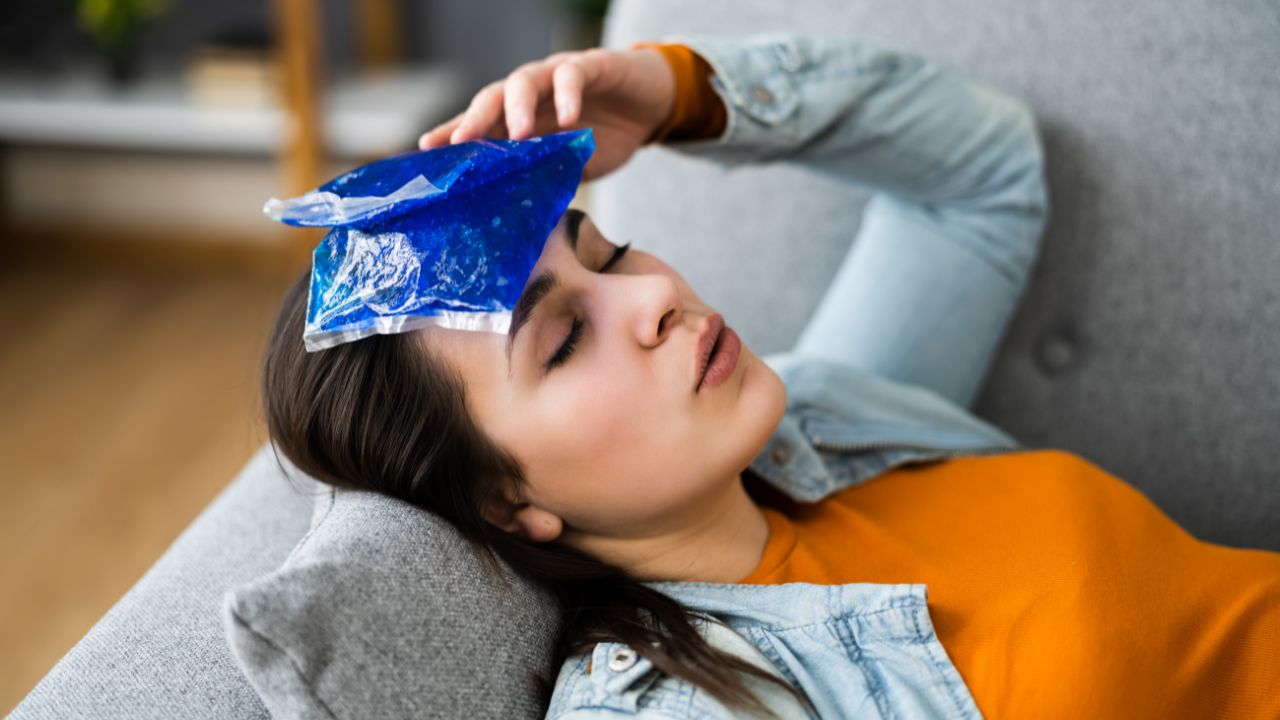
Fever, often a sign of an underlying illness, can leave you feeling uncomfortable and drained. Knowing how to reduce fever safely and effectively is essential for a swift recovery. In this article, Trendbbq will explore various methods and strategies to help you lower your body temperature and feel better sooner. Read on to discover practical ways on how to reduce fever.
Table of Contents,
1. How to Reduce Fever with Hydration
When dealing with a fever, one of the top priorities is ensuring you stay well-hydrated. Fevers tend to cause your body to lose fluids through various means like sweating, respiration, and urination. Dehydration can exacerbate your symptoms and even lead to more severe complications, including but not limited to heat exhaustion, kidney issues, or even seizures.
So, how do you keep those water levels in check? The answer lies in ensuring you’re drinking enough water. This helps you not only replace the water lost but also rebalances essential electrolytes, regulates your body temperature, and aids in the elimination of toxins. A general guideline is to aim for at least eight glasses of water daily, though you may need more if your fever is high or if you’re losing fluids due to excessive sweating.
In addition to water, there are other beverages that can help you stay hydrated, such as juice, soup, tea, or even sports drinks. However, it’s wise to steer clear of alcohol, caffeine, and sugary drinks, as they tend to have a dehydrating effect and can elevate your body temperature. Likewise, avoid consuming extremely cold or hot liquids, as they might induce sudden body temperature changes, potentially leading to shivering or further sweating. The key here is to maintain a steady, balanced intake of water to support your body’s recovery.

2. How to Reduce Fever with Cooling Methods
When it comes to bringing down a fever, there are some practical cooling methods that can help you feel more comfortable by lowering your skin temperature. Let’s explore these options:
- Damp Cloth or Ice Pack: You can start by applying a damp cloth or a gentle ice pack to strategic areas like your forehead, neck, armpits, or groin. These areas have lots of blood vessels close to the surface, which can effectively transfer heat away from your core, assisting in reducing your fever. It’s important to note that you should never place ice directly on your skin, as it can lead to frostbite or nerve damage. Instead, wrap the ice pack in a towel or cloth and keep it moving to avoid localized cooling. Limit the application to no more than 15 minutes at a stretch.
- Lukewarm Bath or Shower: Another effective approach is to take a lukewarm bath or shower. This can not only help lower your body temperature but also ease muscle tension and discomfort. However, steer clear of extremely cold water, which can prompt shivering and raise your body temperature. On the flip side, avoid hot water as well, as it can stimulate blood circulation and increase sweating. Aim to stay in the water for around 20 minutes and be sure to thoroughly dry yourself off afterward.
- Light Clothing and Fans: Consider donning lightweight clothing crafted from breathable materials like cotton or linen. These fabrics promote air circulation and help sweat evaporate, which can provide a cooling effect. Additionally, using a fan to create airflow in your space can further aid in cooling down your skin. Be mindful, though, not to overdo air conditioning or bury yourself under blankets, as this can leave you feeling overly chilly and lead to shivering.

3. How to Reduce Fever with Medication
When it comes to dealing with a fever, sometimes natural methods alone might not do the trick, especially if you’re experiencing more severe symptoms. In such cases, turning to medication can be a helpful way to lower your body temperature and find relief from discomfort. Here are some common medications used to address fever:
- Acetaminophen (Tylenol): Acetaminophen is a readily available over-the-counter pain reliever that can also effectively bring down a fever. It works by inhibiting the production of prostaglandins, which are substances responsible for inflammation and elevated body temperature. It’s considered safe for most individuals, including children and pregnant women. However, it’s crucial to exercise caution and stick to recommended dosages, as excessive intake or mixing with alcohol can lead to liver damage. Always follow the dosage instructions on the label and avoid exceeding 4 grams per day.
- Ibuprofen (Advil) or naproxen (Aleve): Ibuprofen and naproxen are other over-the-counter options that not only combat pain but also work as anti-inflammatories to lower fever by blocking prostaglandin activity. They prove particularly effective for moderate to severe fever and pain. However, they come with certain caveats, as they can potentially cause stomach ulcers, bleeding, kidney issues, or allergic reactions in some individuals. If you have a history of stomach problems, bleeding disorders, kidney disease, asthma, or if you’re taking alcohol or blood thinners, it’s advisable to avoid these medications. Always adhere to the recommended dosage on the label, and do not exceed 1.2 grams of ibuprofen or 660 milligrams of naproxen daily.
- Aspirin (Bayer): Aspirin, another over-the-counter anti-inflammatory drug, can also effectively reduce fever by inhibiting prostaglandin production. It’s especially suitable for addressing high fever and pain. However, similar to the others, it comes with potential side effects like stomach ulcers, bleeding, liver problems, and, in rare cases, Reye’s syndrome, which is a serious condition affecting the brain and liver, mostly in children and teenagers. It’s best avoided if you have a history of stomach problems, bleeding disorders, liver disease, or gout. Also, steer clear of combining it with alcohol or other blood thinners. Follow the dosage guidelines on the label and stay within the 4-gram daily limit.
Remember, it’s essential not to take multiple types of medication simultaneously unless specifically advised by your doctor. Additionally, be diligent in checking the labels of other medications you may be using, such as cough and cold remedies, to ensure you’re not inadvertently taking excessive amounts of ingredients like acetaminophen or any substances that might interact with fever reducers. Your health and safety should always be the top priority when considering medication for fever relief.
4. When to See a Doctor for Fever
Fever is usually a sign of a minor illness that can be treated at home. However, sometimes fever can indicate a serious infection or condition that requires medical attention. You should see a doctor for fever if you have:
- A very high fever: A fever above 103 F (39.4 C) in adults or above 100.4 F (38 C) in children under 3 months is considered very high and may indicate a serious infection or inflammation. You should seek immediate medical help if you have a very high fever along with other symptoms such as confusion, seizures, difficulty breathing, stiff neck, rash, or severe pain.
- A persistent fever: A fever that lasts for more than three days in adults or more than one day in children is considered persistent and may indicate a chronic infection or condition. You should see your doctor if you have a persistent fever along with other symptoms such as weight loss, night sweats, fatigue, or swollen glands.
- An underlying condition: A fever can be more dangerous if you have an underlying condition that weakens your immune system or affects your organs. These conditions include diabetes, cancer, HIV/AIDS, heart disease, lung disease, kidney disease, or liver disease. You should see your doctor if you have a fever along with any signs of worsening of your condition.
- A recent travel history: A fever can be a sign of a tropical disease or an infection that is not common in your area. These diseases include malaria, dengue fever, yellow fever, typhoid fever, or cholera. You should see your doctor if you have a fever within two weeks of traveling to a high-risk area or if you have other symptoms such as diarrhea, vomiting, jaundice, or rash.
5. How to Prevent Fever
Preventing a fever typically involves avoiding or minimizing the underlying causes of fever, such as infections or inflammatory conditions. Here are some steps you can take to reduce your risk of developing a fever:
- Practice Good Hand Hygiene: Wash your hands regularly with soap and water for at least 20 seconds, especially before eating, after using the restroom, and after being in public places. Proper handwashing can help prevent the spread of infections that can lead to fever.
- Get Vaccinated: Stay up to date with recommended vaccinations. Vaccines can protect you from many diseases and infections that can cause fever, such as influenza, measles, and mumps.
- Avoid Close Contact with Sick Individuals: If someone you know is sick, try to minimize close contact with them, especially if they have a contagious illness like the flu or a cold.
- Practice Respiratory Hygiene: Cover your mouth and nose with a tissue or your elbow when coughing or sneezing to prevent the spread of respiratory infections. Dispose of tissues properly and wash your hands afterward.
- Maintain a Healthy Lifestyle: Eat a balanced diet rich in fruits and vegetables to support your immune system. Get regular exercise, manage stress, and get adequate sleep to keep your body in good overall health.
- Stay Hydrated: Drinking enough water helps maintain your body’s normal functions and can help prevent fever caused by dehydration.
6. FAQs
6.1. What is considered a fever, and when should I be concerned?
A fever is typically defined as a body temperature of 100.4°F (38°C) or higher. If a fever persists for more than a few days, is very high (over 104°F or 40°C), or is accompanied by severe symptoms, seek medical attention.
6.2. What are some common ways to reduce a fever at home?
You can reduce a fever at home by staying hydrated, resting, taking over-the-counter fever-reducing medications like acetaminophen or ibuprofen, and applying a cool compress to your forehead and body.
6.3. Is it essential to take fever-reducing medication?
No, it’s not always necessary. Fever is the body’s natural response to infections, and in some cases, it may help fight off the illness. Medication can provide relief from discomfort, but it’s not always required if the fever is mild.
6.4. Is it safe to use cold baths or ice packs to reduce fever?
Cold baths and ice packs should be used with caution. Lukewarm water or cool compresses are generally safer and more comfortable ways to lower body temperature in feverish individuals, especially children.
>>> See more: How to Relieve a Tension Headache: Effective Methods



